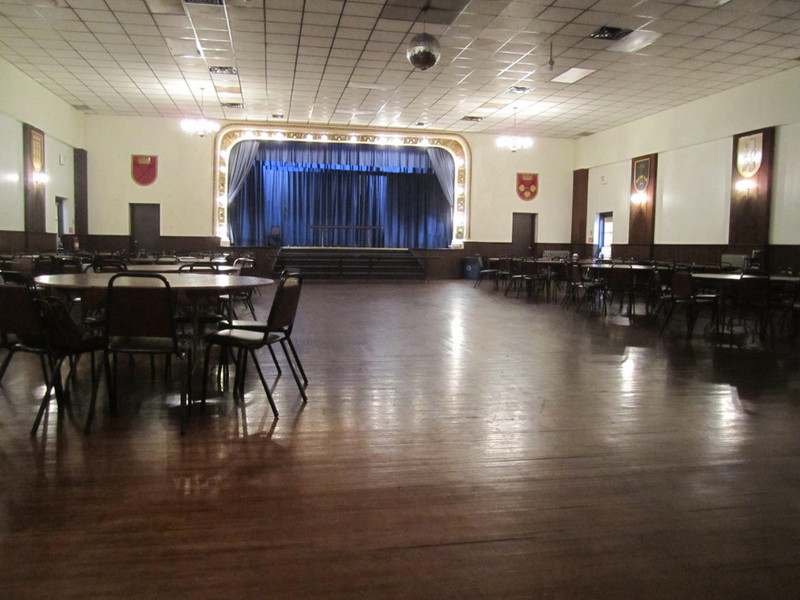The Sachsenheim
Transylvanian Saxon Immigrants Find a Home in Cleveland

According to legend, Prince Vlad III, the fifteenth century Wallachian prince who inspired Bram Stoker to create Dracula, once cruelly impaled a thousand Saxons on stakes in his bloody quest to conquer neighboring Transylvania. While Vlad the Impaler was an actual historical figure and while there is some historical evidence that the Saxons of Transylvania may have crossed paths with him in his incursions in the late 1400s into their lands, the legend itself is likely an exaggerated account of a battle gory by today's standards, but not so much so by those of the fifteenth century. Yet the legend does suggest something about the Transylvanian Saxon immigrants to the United States who, in 1907, purchased a large house at 7001 Denison Avenue in the Cleveland Stockyards neighborhood and converted it into a place they called the Sachsenheim. The word translates literally to "Saxons' Home." As you read a little bit more about the Saxons from Transylvania, you will understand why having a home was so important to them.
The Saxons were ethnic Germans who, at the invitation of King Geza II of Hungary, began immigrating in the twelfth century into Transylvania--at the time a vast, but thinly populated area east of Hungary, near lands further to the east that later became the Romanian principalities of Moldavia and Wallachia. The Saxons called Transylvania "Siebenburgen"--seven towns, after the original seven fortified settlements they built there. Over time they built more towns and villages. As centuries passed, Transylvania--not Germany, became their home. They survived Vlad the Impaler's assault upon their home in the fifteenth century, but the mid-nineteenth century brought a new threat to their home when nationalism took root in eastern Europe. The ruling Hungarians implemented a policy called Magyarization, which aimed at destroying the language and culture of all non-Hungarians. And, the Romanians, by now forming a majority of the population, contended that Transylvania should become part of a Romanian state.
Saxons began leaving Transylvania in large numbers in the late nineteenth and early twentieth centuries. Many came here to Cleveland, where a small colony gradually grew on the west side. By 1895, there was already a sizable number of Saxon immigrants living in Cleveland. Like other immigrant groups did in America's pre-welfare society, they formed a local fraternal benefits organization called Erster Siebenburgen Sachsen Kranken Untersteutszung Verein ("First Transylvanian Saxons Sick Benefit Society") to protect members of their community from catastrophic illness and industrial workplace injury and death. This local organization later led to the creation of a national organization, known today as the Alliance of Transylvania Saxons (ATS) with local branches here in Cleveland and elsewhere in the United States. It was Cleveland's Branch 1 that in 1907 bought and converted the dwelling at 7001 Denison Avenue into the Sachsenheim so that its members would have a place to gather and engage in cultural activities.
The Eintracht Singing Society, organized in 1897, practiced and performed at the Sachsenheim. In 1904, Branch 1 and the Eintracht united, according to an ATS publication, "beginning a period of intensive civic and cultural work in Cleveland." In 1902, Branch 4 was organized for women. Both branches over the years have actively maintained the Sachsenheim as well as planned the scheduling of cultural activities there. In 1905, a second singing society was organized, "Hermania," which in 1922 united with the earlier formed singing society to form Eintracht-Hermania, the predecessor of today's surviving mixed chorus, Eintracht-Saxonia Sachsenchor. Over the years, other cultural groups were organized at the Sachsenheim, including a cultural dance group called the Cleveland Saxon Dance Group. These cultural groups perform today not only here in the United States, but also internationally in Europe.
The Sachsenheim itself changed over the years. Renovations and expansions were made to the building--one in 1910 and and a second in 1925, which added a ballroom, two bowling alleys, a music room, dining room, a restaurant, and other amenities to the facility. The Sachsenheim also opened itself during this era to the Stockyards Neighborhood, allowing local residents and organizations to use the hall for weddings, showers and other events. The restaurant today hosts a weekly Taco Tuesday and is a popular gathering place for young people in the neighborhood.
Over the years since its founding, the Sachensheim has been maintained primarily through revenues raised by the events of the cultural activities groups. The women of the Auxiliary Committee of Branch 4 have for years provided catering services for events at the hall. Money is also raised by the Sachsenheim's bi-annual homemade sausage sale that, according to the ATS, is "well known around town." As a result of the efforts of the two local branches of the Alliance of Transylvania Saxons, as well as that of the singing society Eintracht-Saxonia Sachsenchor, and with help from time to time from other organizations and the residents of the Stockyards neighborhood, the Sachsenheim at 7001 Denison Avenue,while very far away from Transylvania, continues to this day to be the Transylvanian Saxons' home in Cleveland.
Images











